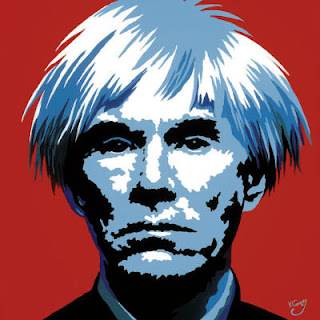It's been 25 years since Andy Warhol died, and the man who gave us the phrase, 15 minutes of fame, is still up there for artists to enjoy and follow.
Next week, he will be even more in the public gaze as his entire estate begins to be auctioned off! The Warhol Museum in Pittsburgh - the largest museum in the United States dedicated to a single artist – is exhibiting examples of Warhol’s source material for his works of art, something that should appeal to afficiandos. Andy Warhol: 15 Minutes Eternal, a retrospective that will travel over two years from Singapore to Tokyo, and indicative of his huge popularity in Asia, is also under way.

Meanwhile, the Metropolitan Museum of Art is doing a show, Regarding Warhol: Sixty Artists, Fifty Years, which features about 45 works by Warhol plus 60 pieces by other artists inspired by him. The exhibition is structured in five thematic sections that aptly describe the world of Warhol: "Daily News: From Banality to Disaster," "Portraiture: Celebrity and Power," "Queer Studies: Shifting Identities," "Consuming Images: Appropriation, Abstraction, and Seriality," and "No Boundaries: Business, Collaboration, and Spectacle."
As the exhibitions kick off to commemorate this important milestone, it is time to reflect on the dramatic, and enduring power of a man who lived totally in his present.
Next week, he will be even more in the public gaze as his entire estate begins to be auctioned off! The Warhol Museum in Pittsburgh - the largest museum in the United States dedicated to a single artist – is exhibiting examples of Warhol’s source material for his works of art, something that should appeal to afficiandos. Andy Warhol: 15 Minutes Eternal, a retrospective that will travel over two years from Singapore to Tokyo, and indicative of his huge popularity in Asia, is also under way.

Meanwhile, the Metropolitan Museum of Art is doing a show, Regarding Warhol: Sixty Artists, Fifty Years, which features about 45 works by Warhol plus 60 pieces by other artists inspired by him. The exhibition is structured in five thematic sections that aptly describe the world of Warhol: "Daily News: From Banality to Disaster," "Portraiture: Celebrity and Power," "Queer Studies: Shifting Identities," "Consuming Images: Appropriation, Abstraction, and Seriality," and "No Boundaries: Business, Collaboration, and Spectacle."
As the exhibitions kick off to commemorate this important milestone, it is time to reflect on the dramatic, and enduring power of a man who lived totally in his present.

